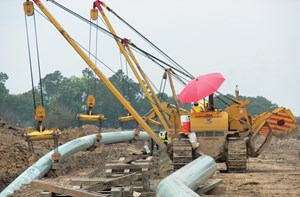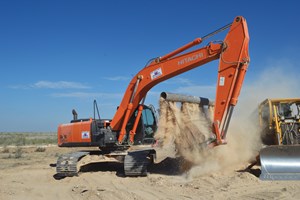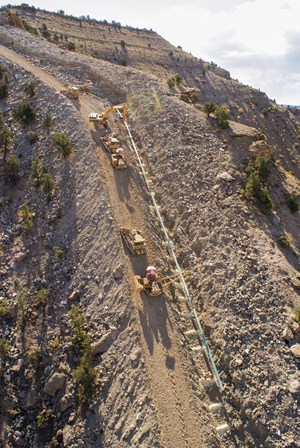November 2019 Vol. 74 No. 11
Features
International Update: Pipeline Construction & Market Trends
Jeff Awalt | Executive Editor
Global demand for natural gas and the infrastructure necessary to deliver it is set to keep growing over the next five years, with ongoing increases in demand across underdeveloped Asian economies and the continued development of international gas trade.
Full-year 2018 data published in the International Energy Agency’s (IEA) June Gas 2019 report show global natural gas demand grew 4.6 percent in 2018 – its fastest pace since 2010 – and accounted for nearly half of the total increase in primary energy consumption worldwide. Demand is projected to rise more than 10 percent to exceed 4.3 trillion cubic meters by 2024.
Demand for crude and condensates, natural gas liquids (NGLs) and other liquids, meanwhile, are projected to grow at a slower 10 MMbpd before plateauing around 108 MMbpd in the 2030s, according to the BP’s 2019 Energy Outlook, which projects growing demand from developing economies met by increased supplies mainly from the US and OPEC.
Pipeline Activity
Global installation activity and expenditure for onshore pipelines in the near-term is expected to be bolstered by a number of large pipelines in Africa, Asia, Eastern Europe and Russia.
The latest exclusive survey by Underground Construction and sister publications Pipeline & Gas Journal using Energy Web Atlas data indicated 145,353 miles of pipelines were planned or under construction worldwide at the start of 2019 – a 73 percent increase over survey findings published in January 2017. Westwood Global Energy, meanwhile, projects a 12 percent increase in additional mileage installed in 2019–2020 and continued capital spending to expand infrastructure beyond this near-term period.
LNG Infrastructure
Developing global LNG markets also remain a key driver for infrastructure demand, including pipelines to deliver natural gas production to new and expanding liquefaction and export facilities in North America and Africa, as well as import facilities and infrastructure to distribute LNG and natural gas in Europe and Asia.
“Despite a rebalancing global LNG market, 2019 will be a record year for LNG project sanction, with in excess of 60 mmtpa of capacity likely to take final investment decisions (FID),” according to Wood Mackenzie. That is well above the previous 45 mmtpa sanctioned in 2005 and a tripling of the 21 mmtpa sanctioned in 2018.
“Other projects in the US, Qatar, Papua New Guinea, Australia and Nigeria are targeting FID in 2019 too, providing upside to our already bullish view,” WoodMac said, citing major projects such as the US$27 billion Arctic LNG-2 in Russia and Golden Pass and Calcasieu Pass in the United States, as well as the small Woodfibre project in Canada.
Two major FIDS have already been announced recently. Cheniere Energy confirmed in June that it will build the sixth liquefaction train at its Sabine Pass LNG export terminal in Louisiana. Also, in June, Anadarko Petroleum formally sanctioned construction of Africa’s largest single LNG project in history.
REGIONAL UPDATES
Africa
Tanzania and Zambia plan to build a refined products pipeline to transport petroleum between the two countries at a cost of $1.5 billion, Tanzania’s Energy Minister Medard Kalemani said. The 840-mile pipeline would connect the commercial capital Dar es Salaam to Zambia’s mining city of Ndola. Kalemani did not provide a construction timeline or financing details but said a feasibility study will be conducted in the coming year.
Uganda’s planned 900-mile East African Crude Oil Pipeline to Tanzania has entered the financing stage, with South Africa’s Standard bank Group and Japan’s Sumito Mitsi Banking Corporation working to help raise debt needed to pay for the $3.5 billion project. The pipeline is designed to export 200,000 bpd of oil to Tanzania from Uganda’s western field, which is controlled by France’s Total, China’s CNOOC and Britain’s Tullow Oil. Development was slowed by disagreements between oil companies and the government on strategy and a delayed decision on the pipeline’s route. More recently, the project has become the target of environmental groups, which have petitioned banks to abandon their funding plans.
Total and Tullow, along with Africa Oil, also reached agreement in principle in June with the government of Kenya on a $3 billion upstream and midstream project to revitalize the country’s oil economy. Project Oil Kenya, which includes a $1 billion pipeline, however, began facing delays almost immediately after it was approved, Petroleum Economist magazine reported. A Tullow Oil operational update predicts the government and partners will reach an FID next year on the project, which would include a $1.8 billion processing facility capable of handling up to 100,000 bpd of oil and a $1.1 billion, 500-mile pipeline to a planned export terminal on the northern coast.
Asia-Pacific, Australia
China – the region’s largest energy consumer – is expected to introduce a plan this year to combine the long-distance pipeline assets of its state-owned energy companies into a single, national oil and gas pipeline group and open access to private and foreign energy producers.
“Economic slowdown, a more considered approach on coal-to-gas switching and increased domestic infrastructure availability will mean LNG demand will slow in 2019, from the 40-45 percent growth we have seen in 2017 and 2018” said Woodmac, which believes domestic supply growth and ramp-up of the Power of Siberia pipeline from Russia will soften LNG demand post-2020. “But China will still grow at around 20 percent, by far the largest source of LNG demand growth in the global market.”
The bulk of construction and installation work is complete, and testing has begun on Gazprom’s 1,864-mile Power of Siberia pipeline, which will transport 38 Bcm of gas from the Irkutsk and Yakutia gas production centers to consumers in Russia’s Far East and to China via its eastern route. The project, begun in 2014, has involved construction of extensive gas processing infrastructure in Russia’s Far East.
Construction of the middle section of the China-Russia east-route natural gas pipeline project, a major energy cooperation project between the two countries, began in Shenyang City of northeast China’s Liaoning Province in July. This key middle section, spanning 685 miles (1,100 km) is expected to alleviate natural gas shortages in northeast China and across the Beijing-Tianjin-Hebei region upon scheduled completion in October 2020.
In South Asia, Indian natural gas company H-Energy Pvt Ltd expects to start its LNG import terminal at Jaigarh in the fourth quarter of 2019, following delays it blamed on monsoons and national elections. The company is also building a 400-mile pipeline connecting Jaigarh, on India’s west coast, to Mangalore, which is expected to be ready by 2023. The new floating storage and regasification unit (FSRU) at Jaigarh will have a capacity of 4 million tons per year of LNG.
Neighboring Pakistan also plans to offer dozens of gas field concessions in the coming year to address a fuel shortage, a senior official told Reuters, with Islamabad hoping a sharp drop in militant violence and changes to exploration policy will attract foreign investors. To encourage development, the government also plans to make its pipeline system more accessible and affordable.
Pakistan’s domestic gas output has plateaued in the last five years, falling to 1.46 trillion cubic feet in 2017/18, from 1.51 Tcf in 2012–2013, according to Petroleum Ministry reports. This has led to severe gas shortages as Pakistan’s population, now at 208 million people, has risen sharply over the same period, driving fuel demand from industries and new power plants higher.
“The entire mechanism of how the pipeline system is working today is being is being re-looked at, to make it more deregulated, make it more open access,” said Nadeem Babar, head of Prime Minister Imran Khan’s Task Force on Energy Reforms.
In Australia, Jemena said it has commenced construction of the Atlas Gas Pipeline, a 38-mile project that will deliver natural gas earmarked for domestic consumption from Queensland’s first domestic-only gas supply. Located approximately 12 miles southwest of Wandoan in Queensland, the Atlas project will include an 8-inch, steel-coated, buried gas pipeline and a compressor station. It will connect gas from Senex Energy’s Atlas gas field to the East Coast gas market via the Wallumbilla Gas Hub.
Jemena’s executive general manager of Gas Markets, Antoon Boey, said construction and commissioning of the Atlas project is expected to be complete before the end of 2019.
“We are acutely aware that Australia faces a gas supply crisis, and Jemena is investing heavily in new gas transmission infrastructure to bring new gas supplies into the market. Moving gas from where it is produced to the markets where it is needed at the lowest possible cost and doing so safely and reliably is of utmost importance to Jemena,” Boey said.
Russia & CIS
Russia has continued to defy U.S. pressure and European efforts to reduce dependence on its vast supply of natural gas. State-owned Gazprom has gained a 36 percent natural gas market share in Europe, and its pipeline projects to extend that share continue unabated.
By mid-June, some 60 percent of the pipelaying for Gazprom’s Nord Stream 2 – about 900 miles – was completed in the Baltic Sea between Russia and Germany, even as U.S. politicians threatened sanctions and Denmark delayed approval of a route through its territorial waters. Pipelaying is currently underway in Finnish waters, and onshore facilities are under construction in Russia and Germany. In Russia, compressor stations and welding are nearly complete on the 544-mile northern gas transmission corridor, which will feed gas into Nord Stream 2.
Nord Stream 2, following the path of Nord Stream, will be a twin natural gas pipeline, with each of the lines spanning 764 miles from Russia to Germany, for a total of 1,530 miles of pipe. Planned capacity of the two strings of Nord Stream 2 is 55 Bcm of gas year.
Earlier this year, Serbia’s Gastrans invited binding bids to book capacity at a planned section of Gazprom’s TurkStream pipeline. The planned 250-mile pipeline through Serbia, which connects the country’s natural gas transmission system to those of Bulgaria and Hungary, is expected to be completed by Dec. 15, with capacity of 13.88 billion cubic meters a year.
While Russia’s natural gas continues to make strides with pipeline expansion, crude oil exports fell to an 11-month low due to oil contamination of the Druzhba pipeline, which usually ships 1 MMbpd, or 1 percent of global oil demand. Russia expects to clean up the pipeline, which was built in the 1960s and carries Russian oil to Europe, including Germany, Hungary, Poland and Slovakia, within four to six months.
Western Europe
The battle for market share between natural gas and LNG in Europe continues to favor lower-cost pipeline gas in Europe, where a projected increase in LNG import volumes was hindered by a mild winter and high inventory levels. While the long-term outlook for LNG demand remains generally favorable for a region seeking to reduce its dependence on Russia, the market for imports from the United States and other regions is expected to be bumpy through 2026.
Laying of the Balticconnector pipeline in the Baltic Sea connecting Finland and Estonia has been completed, and the system is scheduled for connection to ground pipelines in both countries this fall with commercial operations to begin Jan. 1. Gas will flow both ways through the 93.21 miles pipeline, which will have a capacity of 7.2 MMcm per day.
The $341.34 million Balticconnector project, primarily funded by the European Union, will allow Finland to diversify the source of its gas imports, which were previously piped solely by Russia’s Gazprom. Some of the gas to be transported will continue to originate from Russia, but the link will also be able to transport gas that arrives at Baltic terminals in a liquefied state (LNG) and also supplies from continental Europe.
Another planned pipeline linking Norwegian natural gas fields to markets in Denmark and Poland is on track for completion by October 2022, Poland’s Foreign Minister Jacek Czaputowicz said. Poland’s state-run PGNiG has agreed to buy Equinor’s 42.38 percent stake in the Tommeliten Alpha gas and condensate field in Norway and is targeting a total gas output of 2.2 Bcm by 2022 from 0.55 Bcm in 2017.
Construction of the 546-mile Trans-Adriatic Pipeline (TAP), has crossed the mountains of Albania, putting it on track to start delivering gas to Europe next year. Stretching from Turkey’s border across Greece, Albania’s mountains, and the Adriatic Sea to Italy, TAP will transport up to 10 Bcm of natural gas a year from the Shah Deniz II field in Azerbaijan to Italy from next year. Most of the pipelaying has now been completed in Greece and Albania.
After years of delays, Bulgaria has started building a $268 million, 113-mile gas pipeline with Greece that will end the Balkan country’s total dependence on Russian gas and help diversify supplies in southeastern Europe.
Despite plans to build a gas hub and secure natural gas and LNG supplies from different sources, Bulgaria also hopes to keep Russian natural gas flowing through its territory to central Europe. It plans to construct a 280-mile pipeline from its southern border with Turkey to its western border with Serbia to create a link to deliver gas from the TurkStream pipeline to central Europe.
Middle East
The energy landscape of the oil-dominant Middle East continues to evolve following large discoveries of natural gas in the Eastern Mediterranean in the past decade. As the region demands more natural gas primarily for domestic electricity production, Israel and Egypt are seeking to grow exports of gas and LNG, respectively, creating demand for construction of new pipelines and LNG export and import facilities.
Jordan and Iraq are nearing final approval for an $18 billion oil pipeline that would carry 1 MMbpd of oil from the Iraqi city of Basra through the Jordanian port of Aqaba and across the Red Sea to Egypt. The head of Jordan’s Lower House Energy Committee, MP Jamal Gammoh, said that both countries are accelerating preparations for the 1,000-mile pipeline after an agreement was reached between all three nations to extend the pipeline into Egypt. Jordan currently imports 98 percent of its needed energy, using about 134,000 bpd, with most of that coming from Saudi Arabia.
Iraq Prime Minister Adel Abdul Mahdi said his country is close to signing a $53 billion, 30-year energy agreement with Exxon Mobil and PetroChina to build a water injection project to feed oil wells in the south, as well as rehabilitate and build new export pipelines, Abdul Mahdi said.
South-Central America & Caribbean
Development in Argentina’s Vaca Muerta shale continued to gain momentum with a June announcement that ExxonMobil will proceed with construction of pipeline and export infrastructure to support an expected 55,000 oil-equivalent bpd by 2024.
State oil company YPF said it will significantly boost oil and gas production and infrastructure expansion investing between $4 billion and $5 billion per year through 2022. Energy Minister Gustavo Lopetegui said in May that he expects a pipeline construction contract to transport up to 22 million cubic meters of gas production per day from the Vaca Muerta to Buenos Aires to be awarded by September. The pipeline would be more than 400 miles long, according to early projections.
After five years of waiting, the state of Bahia has started construction on the second section of the Gas Southwest pipeline, which will be one of the largest pipelines in the interior of Brazil. With a total planned investment of $100 million, the Southwest Gas pipeline will extend 190 miles, becoming the second largest in the country, connecting municipalities from Ipiaú to Brumado with its three phases. The first, 45-mile section began construction in August 2018 at an estimated cost of $28.5 million. Work on the second 53-mile section, valued at $38 million, began in July, and the final 84-mile section is scheduled to begin construction in September.
In the Caribbean, the generating company AES Andrés, a subsidiary of AES American, began construction of a $100 million, 30.8-mile gas pipeline following an agreement with mining company Barrick Gold. The two companies have signed a 10-year natural gas supply contract to enable the conversion of the Quisqueya I power generation facility from heavy fuel oil to natural gas. The project includes 12-inch branches required for interconnection with the Sultana del Este power plant. •







Comments